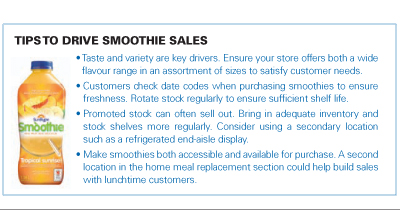Smooth sailing for smoothies
Fuelled by demand for healthy drink alternatives and on-the-go meal solutions, the smoothie category is bursting. The trend started a few years ago with specialty retailers such as Jamba Juice and Jugo Juice. Then restaurants such as Tim Hortons and McDonald’s jumped in. In turn, food companies such as Heinz and Campbell’s have snapped up independent smoothie brands.

Nielsen tracks smoothie sales as part of the Premium Juices & Drinks category. It has grown a healthy 16 per cent in the past 12 months and 36 per cent over the past two years. Nielsen values the Canadian in-store smoothie market at $88 million, while McDonald’s, earlier this year, pegged the total value of smoothies at $212 million. “This is a category we believe is on-trend as consumers look for more health and wellness offerings,” says Evan Ferlejowski, senior product manager for Toronto-based Heinz, which in 2009 paid a reported $11 million to acquire Etobicokebased Arthur’s Smoothies.
Kelowna, B.C.-based SunRype Products Canada is in the midst of a national launch of its SunRype Smoothies, comprised of Berry Delicious and Tropical Sunrise flavours. High fibre in these drinks–four grams per serving–is expected to play a key role in consumer uptake, says Barb Grant, SunRype’s group marketing manager for beverages. Fibre is at the “top of the list” of things consumers want to add to their diet, according to SunRype research.
Heinz’s research, meanwhile, indicates smoothies meet consumers’ quest for essential vitamins and minerals. Smoothies also present an anytime, anywhere healthy meal. They’re most popular at breakfast and lunch, when they are often purchased as a meal replacement.
Arthur’s is currently the No. 2–ranked smoothie brand in a crowded field led by Bolthouse Farms (purchased by Campbell Soup Company for US$1.55 billion earlier this year) and also featuring the Coca-Cola Company’s Odwalla brand, PepsiCo’s Naked Juice and Happy Planet.
New flavours, packaging and manufacturing processes will likely drive the category forward over the next few years, says Paul Parolin, vice-president of sales for Vancouver-based Happy Planet. Companies are working on high-pressure pasteurization techniques to improve freshness and taste. And they’re searching for exotic fruit high in antioxidants that can be combined with other fruit, vegetables and herbs to produce a “functional smoothie” similar to Happy Planet’s Extreme Green, which debuted more than 18 years ago.
SunRype’s Grant says the category offers “great opportunity” for shelf-stable products to capture some of the volume previously done only in the chilled category. “I think there’s a ton of room to grow,” Ferlejowski adds. “There is still low household penetration of this category.” Plus, he notes, it’s one of the few grocery categories that has not yet drawn competition from private-label brands.
Smoothie sales, however, aren’t just for grocery shelves. Nova Scotia grocery chain Pete’s has long operated a 350-square foot juice and smoothie bar at its stores in Halifax. “People are absolutely crazy about specialty drinks or anything unique,” says chief operating officer Dianne Hamilton. She says the popularity of smoothie and smoothie-type beverages among young urban professionals is fuelling annual growth of five to eight per cent at the smoothie bars.
While Pete’s smoothies are a premium-priced product, Hamilton says smoothies are seen as healthy meal replacements, not costly treats. “We’re seeing a much higher level of education around food and I think that has translated into the smoothie trend.”
